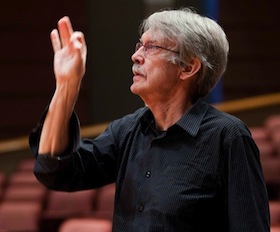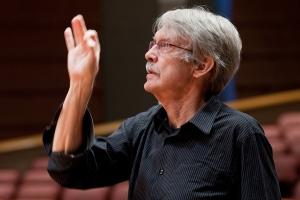
Will the history of John Harbison’s opera The Great Gatsby parallel that of F. Scott Fitzgerald’s novel? Neither the 1999 opera nor the 1925 book was a big hit when they first came out. It took the distribution of 150,000 copies of the book to the armed forces in World War II and a postwar critical reevaluation before Gatsby became a staple read in high schools. Harbison and fans like Metropolitan Opera Music Director James Levine know there’s something haunting about his music that will eventually catch on: Levine scheduled it for a second season in New York in 2002 (after it premiered at the Met, it enjoyed a run at the Chicago Lyric Opera in 2001). Local advocate Nicole Paiement will be conducting it here next month in a chamber version with Ensemble Parallèle at the Yerba Buena Center for the Arts, reorchestrated by Jacques Desjardins.
Harbison provided a vivid illustration of what brings people back to this opera’s music when he, along with Desjardins, sat down with me recently at the San Francisco Conservatory.
Strangely enough, there are favorite [musical] moments that stuck in people’s mind in a mysterious visual way. I remember this one woman at the Met. She wanted to talk and was very emotional. She said, ‘I came back to hear this piece again. I paid $120 for a ticket, and I hated the piece!’ I said, ‘Well, how come you came back?’ She replied, ‘I was haunted by the last scene in that opera — just haunted by it — and I could hear the music in my head. I saw the carrying of that coffin and I saw the guests of the party in the background. I was so haunted, just by the rains falling — but I hated the piece — but I wanted to come back just to hear why that scene was haunting me so much.’ I said, ‘Do you feel any better?’ And she said, ‘No, I hate it, but it’s still haunting me!’It was a very interesting discussion, because the description devolved from the visual to a very strong aural impression. It was persistent; it was definitely sticking. I think it was part of that opera experience that is often true: that some things remain with opera people because of what they saw along with what they heard, but they can’t detach them. That’s why it’s a medium that doesn’t really exist except in performance. The sole use of recordings or videos is to remind people of something they already know about.
Regarding some less-“troubling” aspects of Harbison’s operas, critics are nearly unanimous in praising his evocation of the “Jazz Age” (a term coined by Fitzgerald) by the use of newly composed “1920s” songs (with time-typical lyrics contributed by Murray Horwitz). The New York Times referred to these numbers, which characters dance to at parties, or listen to on the radio, as “ingeniously done.” A dance band separates from the orchestra periodically and performs on stage. While the quaint tunes may sound 90 years in the past, much else is relevant to our own times, according to the composer:
One of the things about the moment of the story is that all the young men are back from war, and they’re in this experience of a very heady fast hell of a country that’s overshooting its means. That’s almost a capsule of what Gatsby’s all about. He’s all speculation. He’s just like the inside traders who didn’t have any real money backing up what they were doing. And there’s a hectic quality about the whole way the people are living, and a kind of hidden quality about how they’re managing to do what they’re doing, which is one of the reasons I think the book is very powerful right now.Also, in a different way, people [of that era] were almost addicted to a realm of sound. The radio was playing everywhere. There were new technologies. One of the things I wanted to do in the piece is have sound in the air, a huge amount. Now we have an addiction to screens. It’s similar, but we have a different visual medium. They had a sonic thing that was just ubiquitous, that was the way they oriented their lives. Music was heard by going to it, and everybody went. So there were bands playing everywhere. You could be at a private party, and expect a band. That was the way society was defining itself. That was one of the reasons I felt I had to write a bunch of songs that would work into the fabric of the piece. A lot of people at the first performances mistook my songs for old songs. I had to educate myself about ’20s music. I’d been a jazz player with a repertoire that began after this period, with the ’30s and ’40s songs. I hadn’t much experienced the vocabulary of that era. I hadn’t listened to many bands that had the old style, with banjo and tuba — very characteristic — which changed very abruptly when the recording era began.
I looked back at some of those tunes, like I’ll Cry for You, with the slow melody and the very fast beat. This style is attached to the fact that the singers were often singing from megaphones, or live. The voices were high; the band singers were tenors or sopranos, because they weren’t using mikes. So one of the things that happens in Gatsby is that the band singer is a tenor.
The quality of the era is going to be emulated at Yerba Buena, as pointed out by Desjardins, who told me that Ensemble Parallèle has recorded the radio music, and “we’re going to process things so they sound like the era.” I then asked him whose idea it was to do the chamber version:
To do the reduction? It was, actually, me, more than four years ago. I had not heard the opera, but I knew of John’s music. I didn’t know that it had a mixed reception in the beginning, but I knew for a fact that if John had written an opera, it would be a safe bet for Parallèle to tackle, because it’s part of our mandate to stage great American operas. He had had only two runs, plus the Met reprise, so we figured that was exactly in our mandate to go out and commission new chamber versions of larger works that are neglected, so we just had to try this. We approached John in early October 2009, right here in the Conservatory. At that point, I had done some pages of Act 1, Scene 3, for his review, so there was a gradual discussion about completing a reduction.
Harbison took favorably to the concept, especially because he was familiar with the successful opera reductions of works by the British composer Michael Tippett by Meirion Bowen. He remarked:
And all of the reduction versions have been more-performed than the big versions. This is important for the circulation of the pieces. Big opera companies of the size of the Met and Chicago are not very numerous anywhere. In Europe, they’re much more numerous, but it’s very hard to get in — there are economic problems in Europe. Within our borders, there’s maybe four [companies] that can actually do the original piece, and the possibilities are very slim.One of the things we came to quickly, in discussing the reduction, was that we had to keep the whole stage band. For almost a third of the piece, the stage band’s playing, so if you remove one instrument from the stage band, you cause yourself migraines forever — basically, it’s an integrated thing.
I’m glad that Harbison gave the green light to Ensemble Parallèle’s new production. Like the one that haunted Gatsby himself at the end of Daisy’s dock, it provides the alluring hope that many more music lovers will have the chance to experience this fascinating American opera.

